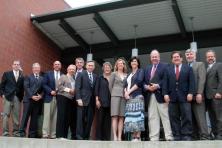“I am kind of a crazed person when it comes to energy because I see it as the biggest opportunity in the United States, should we do it well, and also the biggest opportunity to blow something that we have had in a long time.”
So declared hedge fund mastermind, philanthropist, and clean energy advocate Tom Steyer in a speech to the City Club of Cleveland on April 20, 2012, in which he laid out his business principles for how the United States should think about energy.
Steyer is a national advocate for investing in clean energy solutions to address climate change whose targeted investments in renewable energy research, advanced energy solutions, and community-building strategies are aimed squarely at the intersection of economic development and environmental protection.
He is thus a perfect choice to keynote Climate Solutions’ fifth annual Breakfast, given the organization’s 15-year focus on the economic benefits of the clean energy economy.
When it comes to climate and clean energy, there are two exceedingly obvious realities the United States should be (but is not) reckoning with, which drives Steyer a little crazy: (1) climate change is very real and very serious; and (2) betting on a portfolio of clean energy solutions is good for the nation’s environment and economy.
Passionate about Climate Change
Last weekend Steyer joined up to 50,000 protestors gathered in Washington, DC to send a crystal clear message to President Obama not to allow the construction of the Keystone XL pipeline to move crude oil from Canada to refineries on the Gulf Coast.
Steyer gave the crowd his expert assessment of the Keystone deal: “For the last 30 years I’ve been a professional investor and I’ve been looking at billion-dollar investments for decades and I’m here to tell you one thing: The Keystone pipeline is not a good investment.”
Earlier this year, Steyer offered three observations to the Middlebury College Board of Trustees for why the school should join 350.org’s fossil-fuel company divestment campaign: (1) it can be done; (2) a fossil free portfolio is a good investment strategy; and (3) divestment matters.
“There’s a tendency to say ‘we can’t do this,’ or ‘this will be very hard,’’ Steyer wrote. “But I can tell you, from my experience building one of the country’s larger hedge funds, that this is entirely possible, and well within the skills of your expert advisors whom I know and respect.”
With regard to building the clean energy economy, Steyer is equally emphatic: Moving off of fossil fuels is “absolutely overwhelmingly inevitable. The question is how fast do we do it in the United States. We can lead, we can do a good job, we can apply our brains to it, or we can lose our technological edge and let it be jammed down our throat,” Steyer told a CNN Money reporter on December 8, 2010.
Steyer applies the same principles to the clean energy economy that he learned over his 30-year career in finance—full cost accounting, competition, and long range vision—and believes that it is the government’s role to enable the private sector to do its job.
“The government's job is to set the fair framework so that businesses can do their math and make their investments. This is not going to be done without governmental support,” Steyer observed to CNN Money.
Steyer went on to nail the critical question: “The question is how are we going to have a level playing field so that new energy companies can compete fairly and kick some ass?”
Chasing Excellence
Born in 1957 in New York City, Steyer received his undergraduate degree in Economics and Political Science from Yale University in 1979, graduating Summa Cum Laude Steyer received his MBA from Stanford University in 1983, where he was an Arjay Miller Scholar, a designation awarded to students who graduate among the highest 10 percent of their class.
Steyer worked in Morgan Stanley’s corporate mergers and acquisitions department after college and before business school and joined Goldman Sachs in 1983, where he worked until 1985 as an associate in the risk arbitrage department under Robert Rubin. Rubin served as US Secretary of the Treasury during both the first and second Clinton administrations from 1995-99 and who has remained a critical ally of Steyer’s.
A Wall Street wunderkind, the Wall Street Journal profiled Steyer at the age of 28 along with two other young finance prodigies in June of 1986, commenting that these stars were “attracted to finance because they have been chasing excellence all their lives and success on Wall Street has become the ultimate test.”
In January 1986, Steyer founded Farallon Capital Management, LLC with $15 million in seed money and subsequently built the company into one of the world’s largest hedge funds with assets of $20 billion (as of late 2011) and a reputation for meticulous research, independent thinking, and patience.
Putting His Money Where His Mouth Is
Steyer has amassed an estimated personal net worth of $1.3 billion, according to Forbes, and in August 2010, along with Warren Buffett and Bill Gates, Steyer and his wife of 26 years, Kathryn (“Kat”) A. Taylor, pledged to give away the bulk of their assets. They have wasted no time in making good on that promise.
California Clean Energy Ballot Efforts
In 2010, Steyer spent $5 million of his own money and teamed up with former Secretary of State George Shultz to join many others in defeating California's Proposition 23, an effort by two out-of-state fossil fuel companies and a Koch brothers-controlled company to dismantle California's groundbreaking climate and clean energy law that would have blocked the law’s implementation until unemployment had fallen to 5.5% for one full year.
Steyer described why he got involved in the “No on 23” campaign in his speech to the City Club of Cleveland, observing that there had been a history going back to 1965 of energy companies fighting and winning ballot measures in California, so the assumption was that they could not be defeated.
“I have a slightly bad temper and I was so annoyed and I was lucky enough to hook up with a really good guy, George Schultz, who was a Republican in the Nixon and Ford administrations so it was bipartisan so we could go and figure out how to talk to people about energy in the state of California,” Steyer told the Cleveland audience.
Steyer said that the usual jobs versus the environment frame (“We can’t have any regulation at all or we will go bankrupt” versus “We can’t let you do anything or the environment will be destroyed”) was the wrong approach, while talking about jobs and public health was the right one.
Steyer and Schultz successfully built a strong business and labor coalition that struck preemptively before the opposition realized what they were up against and convinced voters that good climate policy is also the best way to create 21st century jobs. Working with many allies, businesses, and organizations, they garnered the support of over half of the chambers of commerce and won every county. All of us in the climate movement breathed a heavy collective sigh of relief.
Two years later in 2012, at $32.2 million, Steyer was the largest donor to Proposition 39, a successful California ballot measure which changes how multi-state businesses are taxed and is expected to bring in $1.1b annually to CA. For the first five years, half of revenue will be used to expand clean energy and energy efficiency efforts, spending as much as $2.75billion to install new windows, better insulation, energy efficient lighting, heating, and air conditioning at thousands of public schools and other government buildings.
OnePacific Coast Bank
In addition to playing to win on the California political scene in for climate and clean energy, Steyer and Taylor founded OneCalifornia Bank (now One PacificCoast Bank) in 2007, a community development, triple-bottom-line bank designed to serve the needs of underserved people and produce meaningful social justice and environmental benefits, while being financially sustainable. The bank provides funding for numerous renewable energy and community-building projects.
In a unique arrangement that demonstrates just how deep Steyer and Taylor’s commitment is to giving back, they donated $22.5 million to create the OneCalifornia Foundation, (now One PacificCoast Foundation), which owns all of the economic rights of One PacificCoast Bank and engages in charitable and educational activities that support the bank’s goals: programs and initiatives to help eliminate discrimination, encourage affordable housing, alleviate economic distress, stimulate community development and increase financial literacy.
“We wanted the bank to be sustainable, to actually make money, but we didn’t want the money that it made,” Steyer said in an interview when he and Taylor received the 2010 University of San Francisco California Prize for Service and the Common Good. “So what we ended up doing was taking the money it would take to start the bank and putting in into a foundation.”
The acquisition in December 2010 of ShoreBank Pacific, a pioneer of environmentally sustainable banking that started in Ilwaco, Washington and grew to establish offices in Portland and Seattle, prompted the name change to One PacificCoast Bank and greatly expanded the bank’s reach on the West Coast.
“He has the imagination and the guts, frankly, to put his capital and more importantly, his personal reputation on the line to try to make change,” Robert R. Davenport III, Board member of One PacificCoast Bank said of Steyer in a three-minute video produced by SCN Strategies.
Supporting Research and Advocacy for Sustainable Energy Solutions
Steyer and Taylor also donated $65m to Stanford University (where Steyer became a trustee in 2007 and currently serves as Vice Chair of the Board of Trustees) to create two sustainable energy research institutions. The first, the TomKat Center for Sustainable Energy began in January 2009 and works to transform the world’s energy systems by identifying challenges and defining research agendas and innovative solutions.
The second, created in 2010, is the Steyer-Taylor Center for Energy Policy and Finance, which resides at Stanford's Law School and Graduate School of Business and explores and advances public policies and financial mechanism leading to an energy future that protects the environment in an economically sensible way.
In 2011, with Hemant Taneja of General Catalyst Partners, Steyer co-founded the nonprofit Advanced Energy Economy Institute (AEE), a national association of businesses and business leaders whose mission is to influence public policy, foster advanced energy innovation and business growth, and provide a unified voice for a strong U.S. advanced energy industry with the goal of making the global energy system more secure, clean, and affordable.
September 2011 was a very busy philanthropic month for Steyer. First, he and Taylor donated $25 million to the Yale Global Health Initiative to help launch a new Energy Sciences Institute that will bring together physicists, chemists, geologists, biologist, and engineers to develop solutions to the world’s energy challenges. Steyer said the institute will study “clean energy advances [that] are critically needed” to “address the environmental and health concerns associated with fossil fuels.”
Looking Out for Future Generations
The same month, Steyer co-founded the Center for the Next Generation, with his brother, Jim Steyer. Its mission is to shape a national dialogue around two major challenges that impact America’s next generation: advancing a sustainable energy future and improving opportunities for children and families through research, policy development, and strategic communications.
The Steyers also announced a multi-year nationwide campaign called Too Small to Fail to raise awareness of the state of children in America today and that will include advertising, social media, survey research, town hall meetings, and other public events aimed at building support for real investment in programs and policies that benefit children.
“Americans have a choice. We can continue to disinvest in future generations or begin a new period of smart investment that will allow our kids to grow up in a prosperous economy,” the Steyers wrote. “We vote for the latter.”
Major Democratic Party Figure
Steyer is a major figure in the National Democratic party, having donated $1.1 million to the party and individual candidates since 1990, according to the Center for Responsive Politics. He was a delegate to the 2004 and 2008 Democratic conventions and addressed the 2012 delegates in Charlotte, NC on September 5, saying the election was “a choice about whether to go backward or forward. And that choice is especially stark when it comes to energy.”
Seven weeks later in an interview with Reuters on October 24, 2012 about his decision to leave Farallon at the end of 2012, Steyer expressed the paramount need to move beyond fossil fuels and noted with dismay the lack of discussion about climate change in the then-ongoing 2012 presidential debates.
Steyer told Reuters he had a plan: "We immediately get off coal. We move to something that we actually can live with, and proves we can do it in a way that provides a ton of jobs, you know, improves our health, and sets us on a profitable path for the long-term, where we are not causing massive destruction."
The rumors of Steyer running for higher office in California, possibly the United States Senate, or being picked for a Cabinet position in the Obama administration are with good reason. During these bitterly divided times, Steyer’s engagement on the No on Prop 23 campaign revealed his ability to work across the aisle. The Mercury News quoted California Labor Federation Executive Secretary-Treasurer Art Pulaski as saying that this pragmatism sets Steyer apart.
"He's able to bridge ideological divides ... and any problem that he confronts, he's going to solve," Pulaski told the Mercury News. "I don't know where that takes him, but it takes him on a journey that's different from other wealthy people who've run for office before."
Steyer concluded his remarks to the City Club of Cleveland by saying: “We actually have a time when we can turn this from what has traditionally been an American problem since 1950, when we began to import oil, into a real opportunity for us to change how we compete in the world; a chance for us to change how we are viewed in the world; a chance, I believe, to change how we handle the environment going forward, which is why I am a crazy loon on this subject.”
Brilliant, passionate, determined, ethical, pragmatic (and sure, he’ll call himself crazy) when it comes to the critical inflection point and opportunity the world finds ourselves at with climate change—we in the clean energy and climate solutions fields are exceptionally fortunate to have Tom Steyer and Kat Taylor on our side.
—Eileen V. Quigley is Program Director for Climate Solutions’ New Energy Cities program, which is accelerating city-led climate solutions and clean energy innovation in small- to medium-sized Northwest communities. She is a former journalist- and has known Mr. Steyer since 1978 from their days together as undergraduates at Yale University.



